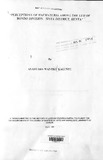| dc.contributor.author | Kagunyu, Anastasia Wanjiku | |
| dc.date.accessioned | 2013-05-03T07:31:36Z | |
| dc.date.available | 2013-05-03T07:31:36Z | |
| dc.date.issued | 1997 | |
| dc.identifier.uri | http://erepository.uonbi.ac.ke:8080/xmlui/handle/123456789/18536 | |
| dc.description | Masters of Arts (Anthropology) | en |
| dc.description.abstract | This study is the investigator's attempt to describe the perception of blood in urine (haematuria ) among the local people of Bondo Division Siaya District. The study was carried out in Got Abiero Sub-Location in Bondo Division. The major objection of the study was to provide useful background information for policy makers, health planners and initiators of rural health intervention programmes and researchers interested in public health in rural areas. In particular the study attempted to examine the relationship between people's traditional practices and their health, their traditional attitudes towards the presence of blood in urine, whether sex is a factor in getting infected by schistosomiasis haematobium, and whether some sanitaryconditions facilitate schistosomiasis haematobium infections. It was hypothesized that schistosomiasis haematobium infection is related to contact with water bodies; associated with gender based kinship roles; associated with sanitary conditions; and the folk aetiological notions of the study are. As a theoretical framework socializing theory was used to explain people's perceptions in relation to .blood in urine. A sample of one hundred and fifty respondents was drawn using non-probability sampling technique. It includes both adult males and females. The data were collected through structured questionnaire interview, non-participant observation and key informants. These data were analyzed by frequencies and cross tabulation. Findings suggest that blood in urine is prevalent in the study area since more than half of all those people who were interviewed indicated that they have seen blood in their urine, at one time or the other and that they had cases of blood in urine among their school going children. The data analysis revealed that the disease is well known in the region since its local name was given as aremo and again traditional herbs for treating it were known by almost every respondent. Study came- up with the following results ponds and streams are used in the study area and they act as source of Schistosomiasis infection; gender based kinship roles facilitate individuals' coming into contact with contaminated water lack of sanitary facilitates the rate of infection in the stud" area since more than half of those who were interviewed lacked latrines in their homes and they excrete anywhere. Last but not least the local people lacked | en |
| dc.language.iso | en | en |
| dc.title | Perceptions of haematuria among the Luo of "Bondo division, Siaya district, kenya" | en |
| dc.type | Thesis | en |
| local.publisher | Institute of Anthropology, Gender & African Studies, University of Nairobi | en |

